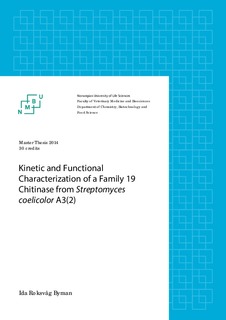Kinetic and functional charaterization of a family 19 chitinase from Streptomyces coelicolor A3(2)
Master thesis
Permanent lenke
http://hdl.handle.net/11250/216791Utgivelsesdato
2014-08-06Metadata
Vis full innførselSamlinger
- Master's theses (KBM) [890]
Sammendrag
The aim of this study was to obtain further insight in family 19 chitinases by carrying out a kinetic and functional characterization of a bacterial family 19 chitinase from Streptomyces coelicolor A3(2). There are many family 19 chitinases, but it is still not quite clear what these enzymes do. More fundamental enzymology is needed to learn about the details of these enzymes. Calculating kinetic parameters like Km and kcat under various conditions and for various substrates can provide such details. In the present study, Chitinase G from S. coelicolor A3(2) was expressed in a pETM11 vector and purified using immobilized-metal affinity chromatography. After method development to establish reliable quantitative analysis of reaction products, kinetic parameters were obtained from enzyme assays using natural soluble chitooligosaccharides as substrates. Km and kcat for (GlcNAc)3, (GlcNAc)4 and (GlcNAc)5 were 4.9 (± 0.8) × 103 µM and 215 (± 21) s-1, 5.6 (± 0.40) × 102 µM and 584 (± 14) s-1 and 5.3 (± 0.84) × 102 µM and 451 (± 24) s-1, respectively. The similar Km values of the tetramer and the pentamer indicate that the enzyme has only four substrate-binding subsites. In addition, enzyme assays were performed at pH 4 to 8 using (GlcNAc)4 as substrate, which revealed minimal effect on the enzyme activity. Chitinase G activity towards other substrates than chitin was tested, including other polysaccharides, cell walls of some bacteria and a fungus, using size exclusion chromatography and MALDI-TOF mass spectrometry for product analysis. However, no novel activities were detected. High Km values obtained from enzyme assays indicate low affinity towards the substrates tested, even though high kcat values may indicate that the main substrate target is chitin, or at least a beta-1,4 glycosidic bond between two N-acetylglucosamines, after all. More research is needed to understand the biological roles of these enzymes.
